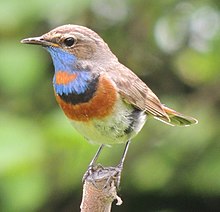Luscinia
| Luscinia | |
|---|---|

| |
| Adult male bluethroat (Luscinia svecica) | |
| Scientific classification | |
| Domain: | Eukaryota |
| Kingdom: | Animalia |
| Phylum: | Chordata |
| Class: | Aves |
| Order: | Passeriformes |
| Family: | Muscicapidae |
| Genus: | Luscinia T. Forster, 1817 |
| Type species | |
| Luscinia aedon[1] T. Forster, 1817
| |
| Species | |
|
Several, see text | |
| Synonyms | |
| |
Luscinia is a
Taxonomy and systematics
The word Luscinia was used for nightingales and similar birds in
Delimitation of Luscinia versus the genus
The species currently placed in Luscinia are:[5]
- Bluethroat, Luscinia svecica
- White-bellied redstart, Luscinia phaenicuroides (previously the only species in the genus Hodgsonius)
- Thrush nightingale, Luscinia luscinia
- Common nightingale or rufous nightingale, Luscinia megarhynchos
Description
The Luscinia species are stocky small birds, 13–16 cm long with an upright stance and a moderately short frequently cocked tail. They watch for
In the two species named as nightingales, the sexes are similar. They are plain brown above, whitish below with light streaking, and have a rufous tail. In the other Luscinia species, the male is much brighter than the
They are birds of
The breeding habitat is typically scrub or forest, and their cup nest is usually constructed low in a bush. The birds can be difficult to see in dense undergrowth, especially if not singing, but they may frequent somewhat more open habitats in their winter quarters.[7]
Fossil record
Luscinia denesi (Late Miocene of Polgardi, Hungary) [9]
Luscinia pliocaenica (Pliocene of Beremend, Hungary) [9]
References
- ^ "Muscicapidae". aviansystematics.org. The Trust for Avian Systematics. Retrieved 2023-07-15.
- ^ Lewis & Short (1879), Glare (1968-1982)
- ^ Mayr, Ernst; Paynter, Raymond A. Jr. (1964). Check-list of Birds of the World. Volume 10. Vol. 10. Cambridge, Massachusetts: Museum of Comparative Zoology. p. 32.
- ^ Forster, T. (1817). A synoptical catalogue of British birds; intended to identify the species mentioned by different names in several catalogues already extant. Forming a book of reference to Observations on British ornithology. London: Nichols, son, and Bentley. p. 14.
- ^ a b Gill, Frank; Donsker, David, eds. (2016). "Chats, Old World flycatchers". World Bird List Version 6.2. International Ornithologists' Union. Retrieved 20 May 2016.
- PMID 20656044.
- ^ a b c d Grimmett et al. (1999), Svensson et al. (1999)
- ^ Hír et al. (2001), Mlíkovský (2002)
- ^ a b Kessler, E. 2013. Neogene songbirds (Aves, Passeriformes) from Hungary. – Hantkeniana, Budapest, 2013, 8: 37–149.
Sources
- Glare, P. G. W. (ed.) (1968–1982): ISBN 0-19-864224-5
- Grimmett, Richard; Inskipp, Carol, Inskipp, Tim & Byers, Clive (1999): Birds of India, Pakistan, Nepal, Bangladesh, Bhutan, Sri Lanka, and the Maldives. Princeton University Press, Princeton, N.J. ISBN 0-691-04910-6
- Hír, János; Kókay, József; Venczel, Márton; Gál, Erika; Kessler, Eugén (2001). "Elõzetes beszámoló a felsõtárkányi "Güdör-kert" n. õslénytani lelõhelykomplex újravizsgálatáról" [A preliminary report on the revised investigation of the paleontological locality-complex "Güdör-kert" at Felsõtárkány, Northern Hungary]. Folia Historico Naturalia Musei Matraensis. 25: 41–64. Archived from the original on 2007-12-11. Retrieved 2009-05-19. [Hungarian with English abstract].
- Jønsson, Knud A.; Fjeldså, Jon (2006). "A phylogenetic supertree of oscine passerine birds (Aves: Passeri)". S2CID 85317440.
- Lewis, Charlton T. & Short, Charles (eds.) (1879): A Latin Dictionary (1st ed.). Oxford University Press, Oxford.
- Mlíkovský, Jirí (2002): Cenozoic Birds of the World (Part 1: Europe). Ninox Press, Prague.
- Seki, Shin-Ichi (2006). "The origin of the East Asian Erithacus robin, Erithacus komadori, inferred from cytochrome b sequence data". PMID 16529957.
- Svensson, Lars; Zetterström, Dan; Mullarney, Killian & Grant, Peter J. (1999): Collins Bird Guide. Harper & Collins, London. ISBN 0-00-219728-6
